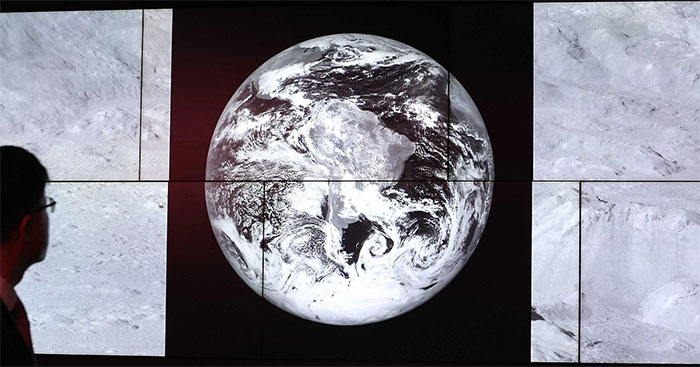Efforts to protect the Moon's surface from mining and experimental activities
Over the past two decades, research on the Moon has revealed the rich resources on Earth's natural satellite.
Some locations on the Moon are eligible for bases and structures that would be protected from cosmic radiation by protruding rocks. Deep holes at the Moon's poles also contain ice - a valuable source of water, oxygen and hydrogen. Some other holes are located near high mountain ridges and can receive light from the Sun all year round, so they play an important role in exploiting solar energy. Notably, the Moon also has many other valuable resources such as titanium, aluminum, helium-3, precious metals and rare earths.

Images of the Moon taken by Korea's Danuri unmanned probe were displayed at an exhibition in Seoul on December 26, 2023. (Photo: Yonhap/TTXVN).
The Moon's abundant potential has become 'sweet honey' for space agencies and private companies. They plan to build a base on the Moon , conduct scientific experiments and mine. The moon has three times the surface area of Antarctica, so overcrowding is not a major concern. However, there are only a few areas on the Moon's surface suitable for scientific experiments, so it is expected to attract a lot of missions and other activities.
Researchers want to protect scientifically important sites (SESI) on the surface of the Moon . The immediate task is to classify which sites need which type of protection. Scientist Alanna Krolikowski at Missouri University of Science and Technology (USA) commented: 'Scientists need to carefully consider the fact that scientific assets are at risk and need to proactively classify them. into the category worth protecting'.
Ms. Alanna Krolikowski is a co-author of a study on SESIs published by the Royal Society Academy of Sciences on March 25. The study emphasizes the need for a multifaceted approach to protect SESI. In addition, governments' space policies need to include SESI protection. This is what puts the most pressure on countries planning to carry out missions on the Moon.
According to the report, there are two major international efforts to establish regulations for activities on the Moon, but protecting SESI has not received attention.
The first is the Artemis Agreement between the US and partner countries in the Artemis lunar exploration program. According to the agreement, there are specific safety zones around the installed equipment. However, the Artemis Accords allow private companies to exploit the Moon for profit.
The second is the Moon stewardship effort by the United Nations Committee on the Peaceful Uses of Outer Space. The committee's new working group is considering regulations for natural resource exploitation on the Moon, and there is an expectation that it will pay attention to SESI.
- Discovering more activity on the two moons of Saturn
- Interesting things about the moons in the Solar System
- Mining from asteroids
- In just a decade, people will start mining in space
- Mongolia: The price paid for the environment
- Australia: Prohibit mining to protect spiders
- What terrible disaster will happen if the Earth has 67 moons?
- Human activity has caused nearly 1,000 earthquakes
- Experimental new ways to exploit methane hydrate
- The truth is hard to believe: A pair of experimental mice can be as expensive as a billion-dollar car
- China dreams of flying to the moon
- Ambition to exploit the moon
 Van Allen's belt and evidence that the Apollo 11 mission to the Moon was myth
Van Allen's belt and evidence that the Apollo 11 mission to the Moon was myth The levels of civilization in the universe (Kardashev scale)
The levels of civilization in the universe (Kardashev scale) Today Mars, the sun and the Earth are aligned
Today Mars, the sun and the Earth are aligned The Amazon owner announced a secret plan to build a space base for thousands of people
The Amazon owner announced a secret plan to build a space base for thousands of people